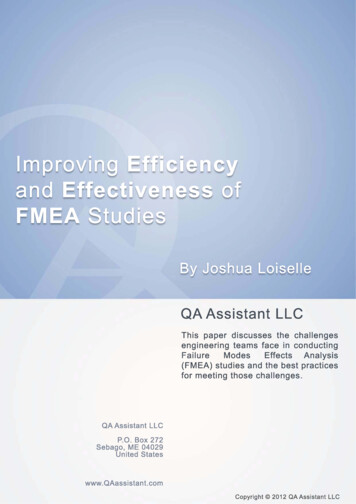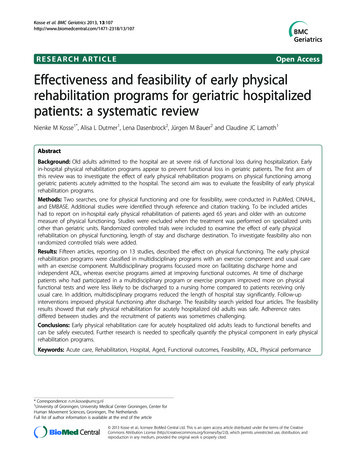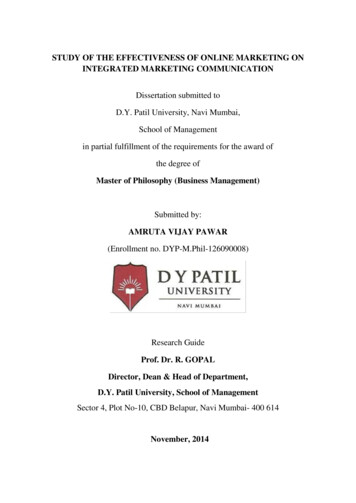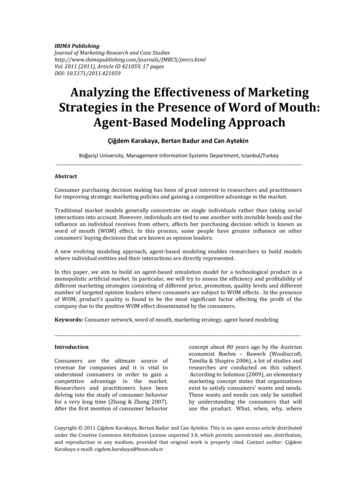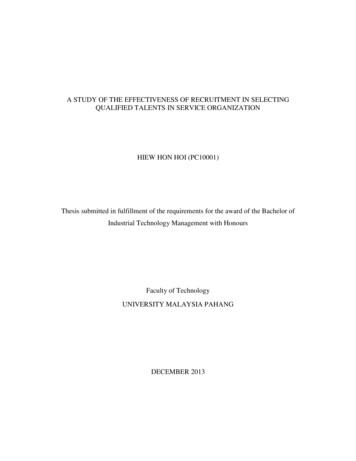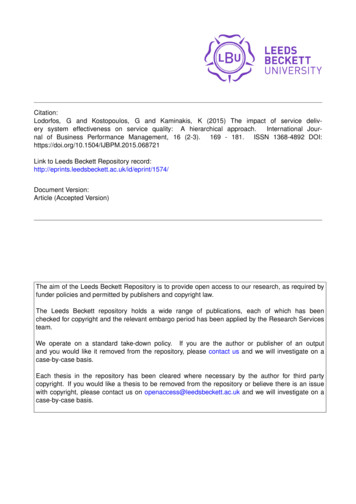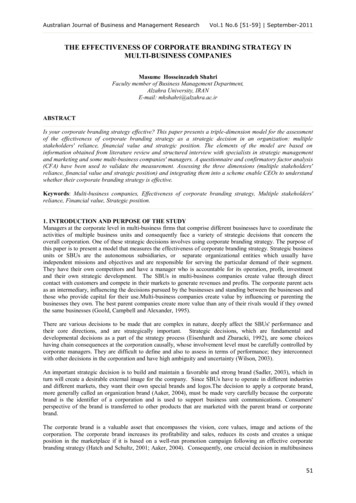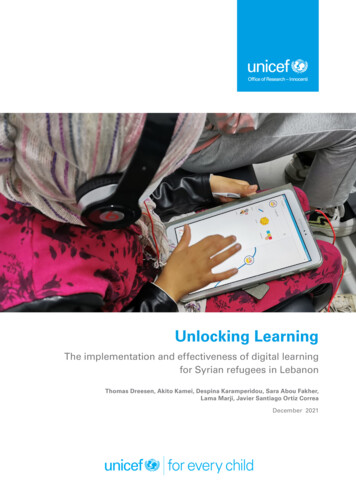
Transcription
Unlocking LearningThe implementation and effectiveness of digital learningfor Syrian refugees in LebanonThomas Dreesen, Akito Kamei, Despina Karamperidou, Sara Abou Fakher,Lama Marji, Javier Santiago Ortiz CorreaDecember 2021
UNICEF OFFICE OF RESEARCH – INNOCENTIThe Office of Research – Innocenti is UNICEF’s dedicated research centre. It undertakes research onemerging or current issues in order to inform the strategic direction, policies and programmes of UNICEFand its partners, shape global debates on child rights and development, and inform the global researchand policy agenda for all children, and particularly for the most vulnerable.UNICEF Office of Research – Innocenti publications are contributions to a global debate on children andmay not necessarily reflect UNICEF policies or approaches.The Office of Research – Innocenti receives financial support from the Government of Italy, while fundingfor specific projects is also provided by other governments, international institutions and private sources,including UNICEF National Committees.The findings, interpretations and conclusions expressed in this paper are those of the authors and do notnecessarily reflect the views of UNICEF.This paper has been peer reviewed both externally and within UNICEF.The text has not been edited to official publications standards and UNICEF accepts no responsibility forerrors.Extracts from this publication may be freely reproduced with due acknowledgement. Requeststo utilize larger portions or the full publication should be addressed to the Communications Unit at:Florence@unicef.org.Any part of this publication may be freely reproduced if accompanied by the following citation:Dreesen T., Kamei A., Karamperidou D., Abou Fakher S., Marji L., and Santiago Ortiz J., Unlocking Learning:The implementation and effectiveness of digital learning for Syrian refugees in Lebanon. UNICEF Officeof Research – Innocenti, Florence, 2021.Correspondence should be addressed to:UNICEF Office of Research – InnocentiVia degli Alfani, 5850121 Florence, ItalyTel: ( 39) 055 20 330Fax: ( 39) 055 2033 220florence@unicef.orgwww.unicef-irc.orgtwitter: @UNICEFInnocentifacebook.com/UnicefInnocenti 2021 United Nations Children’s Fund (UNICEF)Cover photo: War Child HollandGraphic design: Small World Stories
Unlocking LearningThe implementation and effectiveness of digital learningfor Syrian refugees in LebanonThomas Dreeseni, Akito Kameii, Despina Karamperidoui, Sara Abou Fakherii,Lama Marjiii, Javier Santiago Ortiz CorreaiiUNICEF Office of Research – InnocentiiiUNICEF Lebanon Country OfficeDecember 2021
Unlocking LearningThe implementation and effectiveness of digital learning for Syrian refugees in LebanonAcknowledgementsThe authors prepared this report under the supervision and guidance of Matt Brossard, Chief of Education,UNICEF Office of Research – Innocenti. Qualitative data collection was conducted by Sara Abou Fakher andLama Marji, with technical support from Michelle Mefeae and Despina Karamperidou.Valuable inputs were provided throughout the research process by colleagues from UNICEF Lebanon (MichelleMefeae, Ghinwa Itani, Hassan Rajab, Souad Al Sarraf, and Olena Sakovych) UNICEF Middle East and NorthAfrica (Alassane Ouedraogo, Yazeed Sheqem, Hind Omer, and Momo Duehring) and UNICEF Education, NYHQ(Rachel Cooper, Pragya Dewan, Juan-Pablo Giraldo and Auken Tungatarova).Amparo Barrera and Lara Stefanizzi provided invaluable administrative support to the team. The team wouldalso like to acknowledge the leading role that Philippe Testot-Ferry, the UNICEF-Akelius Foundation PartnershipLead, and Juan Pablo Giraldo (Education Specialist, UNICEF NYHQ) have provided throughout the evidencegeneration process. Thanks also goes to Céline Little, Kathleen Sullivan, Sarah Marchant and Silke Rechenbachfor their support with the editing and communication of this research. The research team is grateful for theinputs of Anthony Bloome (Director, M-Education Alliance) and Tom Kaye (Country Engagement Manager,EdTech Hub) who served as external reviewers.Our special thanks goes out to the staff and teachers from Ana Aqra, Lebanese Organization for Skills andTraining (LOST), Mouvement Social and War Child Holland, the entire UNICEF Lebanon Education team, andthe management and development team from the Akelius Foundation, who provided us with their time andexpertise, and without whom this programme and research would not be possible.4
Unlocking LearningThe implementation and effectiveness of digital learning for Syrian refugees in LebanonContentsExecutive summary61. Introduction91.1. Education for Syrian refugees in Lebanon101.2. Non-formal education as a bridge to formal learning101.3. The introduction of the digital course in NFE classrooms112. Methods and research objectives132.1. Quantitative data sources and analysis132.2. Qualitative data collection133. Findings153.1. Pre COVID-19: In-class use of the digital course and perceived effects153.2. Transition to digital remote learning163.3. Effectiveness of digital remote learning213.4. Effects beyond students’ learning254. Conclusions and recommendations26AnnexesAnnex A - Demographic charactristics of children by the digital course use 28Annex B - Sampling for qualitative data collection 29Annex C - Examples of assessment tools for language and art development (CB-ECE) 30Annex D - Robustness checks for empirical analysis and additional analysis 315
Unlocking LearningThe implementation and effectiveness of digital learning for Syrian refugees in LebanonExecutive summaryThe COVID-19 pandemic resulted in school closures around the world, at its peak affecting 1.6 billion studentsworldwide (UNESCO, 2020). This crisis has underscored the importance of resilient education systems thatcan support all, especially the most marginalized, to learn during times of crisis. Even before the COVID-19pandemic, nearly one in four children globally were living in countries affected by conflict or disaster, unableto routinely access quality education (UNICEF, 2016). The growing use of digital technologies in education(commonly referred to as EdTech) during COVID-19 school closures has heighted the need to understand howto best use EdTech in humanitarian and crisis contexts.This report presents findings from the UNICEF-Akelius Foundation Innovation in Education Partnership and itsimplementation of a digital course used on tablets and mobile phones for language learning in Lebanon, where40 per cent of school-age children and adolescents are Syrian refugees. The digital course was introduced innon-formal education (NFE) classes for Syrian refugees to strengthen English or French language learning andhelp their transition to Lebanon’s trilingual education system, where classes are taught in Arabic, French andEnglish.The goal of the digital course examined in this research is to provide students and teachers with a tool toaccelerate language learning for marginalized children. The digital course is free, includes no advertising andrequires no prior user information to access. It can be accessed online via a web browser, or online andoffline (when content is downloaded) through a mobile application on tablets or mobile phones. The contentand features of the course are developed through a co-creation approach with frequent communication andfeedback from implementing teachers based on the real-world use of the course with students (see Image 1).Image 1. Examples of the Akelius Digital Language Course contentWhen first implemented in Lebanon in 2019, the course was used in three centres serving 246 students as ateaching tool within traditional face-to-face classrooms. In class, students used the course on individual tabletswith headphones and were guided by teachers who were present. However, when schools and educationcentres in Lebanon closed in March 2020, the course was implemented in a fully remote learning environmentand expanded across the country to 64 NFE centres covering a total of 7,237 refugee students.As a result, this report presents analysis on the implementation of the digital course in three key areas:First, the report investigates the digital course’s use in a blended learning environment where it was used ontablets by students as part of traditional face-to-face classroom instruction with teachers. Second, the analysisexamines the transition to remote learning where the course was used on devices owned by the household,supported by teachers remotely. Third, the report estimates the effectiveness of the use of the digital courseduring this period of remote learning from August–November 2020.6
Unlocking LearningThe implementation and effectiveness of digital learning for Syrian refugees in LebanonSummary of key findings:1. When used during in-person classes, qualitative evidence from teachers indicates that the course ledto improvements in their classroom environment, students’ confidence, motivation to go to class andspeaking skills.2. The successful transition to remote digital learning relied on frequent, clear communication betweeneducators and households and ongoing support from educators to overcome challenges, includingunreliable internet connectivity and distrust of technology within the community.3. In both face-to-face and remote settings, teachers remained the key to successful implementationof digital learning. When centres closed, teachers gave additional support to students and familiesbeyond their already challenging role of teaching from a distance. They provided psychosocial support tofamilies, as well as technological support by developing and delivering guides on how to use technology,providing data package top-ups and even helping to install internet routers within communities.4. When implemented in a fully remote learning environment, students from classes that introduced thedigital course showed statistically significant improvements in foreign language (French or English,21.2 per cent increase; Arabic, 21.1 per cent increase), and art (11.1 per cent increase) competenciescompared to students from centres that didn’t use the digital course. These findings are robust whencontrolling for baseline learning levels of students, demographic characteristics and the location of thelearning centre. War Child Holland7
Unlocking LearningThe implementation and effectiveness of digital learning for Syrian refugees in LebanonRecommendations for policymakers, education practitioners, andEdTech developersEducation systems and practitioners were unprepared for the unprecedented schoolclosures due to the COVID-19 pandemic and rapidly adapted to provide learning for children.Governments need to build resilience in education systems and, as part of that process,have a systems approach to providing equitable digital learning whether the classroom isphysical or virtual. The following are recommendations from the experience of the UNICEFAkelius Foundation partnership in Lebanon: Governments should prioritize investments in reliable electricity and connectivityinfrastructure, especially for hard-to-reach and marginalized areas and populations.Work must be done at the same time with the private sector to ensure low-cost andaffordable data, all of which are needed to enable equitable digital learning. Educationpartners across Lebanon cited connectivity as the major barrier faced when providingdigital remote learning, compounded by the high cost of data. Frequent communication with families and communities should continue beyondremote learning to sustain increased caregiver engagement in their children’slearning. Education coordinators noted that caregivers were more engaged in theirchildren’s learning while using the digital course at home. For refugee families with lowtrust of institutions, the trust and relationships built with community-based NFE actorscontinues to be critical to encourage families to pursue education for their children. Education providers must invest in the digital skills of teachers and facilitators andtheir readiness for digital learning, whether in the remote or physical classroom.Implementation of digital learning during school closures varied between centres,partners, and teachers. Many times those differences were based on the capacities ofteachers and various technological constraints in communities. Investments in the digitalskills of teachers and facilitators need to be met with ongoing support and guidance forthem on how to effectively integrate technology into their teaching practice. The support system needed to enable digital learning must be invested in,and the key role of teachers in successful implementation of EdTech must beacknowledged and supported. Teachers provided extra-academic support to familiesin alleviating technology and connectivity issues throughout school closures. The useof technology for learning requires much more than a device held by a student and anengaged teacher. Governments and education providers should cost and invest in the entiresupport system for digital learning, including in human resources to alleviate technologicaland connectivity challenges, monitoring and evaluation systems, and implementationresearch to understand how digital learning works. Doing so would reduce the burdenthat falls on individual teachers or organizations to provide technology support on top oftheir regular teaching duties. Software developers should design programs and prioritize application featuresthat align with the needs of teachers and to the constraints of the learningenvironment. While interactive and engaging content should be a priority, it must becoupled with EdTech solutions designed to be used in low- or no-connectivity settings.8
Unlocking LearningThe implementation and effectiveness of digital learning for Syrian refugees in Lebanon1. IntroductionThe use of EdTech in education has been long advocated for its potential to improve student outcomes throughseveral pathways. Software can be designed to encourage and support self-paced learning that is typicallydifficult to achieve in group instruction, especially large classes (Koedinger et al., 1997; Roschelle et al., 2000;Rodriguez-Segura, 2021). Computer Assisted Learning (CAL) programs can enable adaptive learning whereeducation content delivered on the screen is individualized based on the strengths and weaknesses of thestudent (Muralidharan et al., 2019). While EdTech programmes may have a wide variety of goals, such asimproving literacy and numeracy, or language skills, the use of EdTech can also help build students’ digitalskills, which is increasingly important as economies transform and become more digital (Flack et al., 2020).However, while the potential is great for EdTech to support good practices in education and pedagogy, suchas teaching at the right level, the evidence on effective use of technologies to improve children’s outcomesis mixed. What has become clear is that the introduction of technology has had large and positive effects forstudents and teachers when introduced into a clear teaching framework (Brossard et al., 2021; Bulman andFairlie, 2016). In short, while the choice of the technological tool or software is important, how it is effectivelyused by teachers and students to achieve learning outcomes is even more critical.In the context of education in emergencies, the use of mobile technologies can also enable access to learningopportunities when education systems are disrupted (Tauson and Stannard, 2018; De Hoop et al., 2019).In 2020, the COVID-19 pandemic and related school closures accelerated the take-up and use of mobiletechnologies to support children’s learning. These education institutions’ closures have also highlighted theconsiderable inequities of children’s access to the technologies needed for remote learning, and the lack ofpreparedness of education systems across the globe to effectively use technology for learning (UNICEF, 2020;UNICEF 2021). So, while EdTech solutions have the potential to address education challenges in low-resourceand conflict settings, where class sizes may remain large and learning levels remain low, (UNICEF, 2019; Savethe Children, 2019) these contexts are also the least likely to have the human resources and infrastructureneeded to use EdTech effectively and at scale (Dreesen et al., 2020).This report aims to add to the growing evidence base on the use of EdTech in low-resource settings. Inparticular, the report presents findings on two until now relatively sparsely researched topics: The use andeffectiveness of EdTech in a protracted humanitarian context (for Syrian refugees in Lebanon) and the transitionto, and effectiveness of, EdTech for remote learning during COVID-19. More specifically, this research focuseson the implementation of the Akelius Digital Language Learning Course (subsequently referred to as the digitalcourse) in NFE classes in Lebanon that serve Syrian refugee children.Box 1. The UNICEF-Akelius Foundation Innovation in Education PartnershipIn 2017, UNICEF Headquarters, UNICEF Sweden and the Akelius Foundation engaged in a partnershipto support UNICEF Education in Emergencies (EiE) programmes.The partnership embarked on the co-creation of the digital course with local implementing educatorsstarting in Greece in 2017 and subsequently expanding to Lebanon, Mauritania, Bosnia andHerzegovina, Serbia and Italy. The digital course, used on tablets, mobile phones or computers, is atool to support language learning among refugees, migrants, and linguistic minorities around the world.The partnership aims to help children learn languages to facilitate their inclusion into schools in hostcommunities and societies more broadly.Within the partnership there is a strong emphasis on evidence generation to track progress, learn,inform, and improve implementation. In each context, resources are invested to understand howimplementation of the digital learning course works towards improving learning for children andadolescents. This research is part of a series of reports examining the use of the digital course forchildren’s learning – the first report explored the co-creation, use and effectiveness the digital course inGreece (Karamperidou et al., 2020).9
Unlocking LearningThe implementation and effectiveness of digital learning for Syrian refugees in Lebanon1.1Education for Syrian refugees in LebanonDriven by the influx of Syrian refugees into the country, the population of Lebanon rose from 5.2 million in2011 to 6.9 million in 2019 (World Bank, 2021). An estimated 1.5 million Syrian refugees are present in Lebanon(UNHCR, 2020). This increase in population has put great strain on the Lebanese education system, as 40 percent of school-age children and adolescents in Lebanon are Syrian refugees (UNICEF, 2021). To respond to thiscrisis, the Ministry of Education and Higher Education (MEHE) has undertaken multiple initiatives to provideSyrian refugee children and adolescents access to education. These efforts include waiving primary schoolfees and offering a second afternoon shift in public primary schools to increase education access for Syrianchildren (de Hoop et al., 2018). However, even with these policies implemented, more than half (57 per cent)of Syrian refugees remain out of education in Lebanon (Human Rights Watch, 2021).Refugee children in Lebanon face numerous challenges to access education and achieve quality learning. As 58per cent of Syrian refugee households live in extreme poverty the opportunity cost of attending school can bevery high (El-Ghali et al., 2019). Distance to schools, and the complex transportation system to bring childrento schools, discourages enrolment and attendance, especially for girls (Human Rights Watch, 2016). In manycases there is a lack of awareness and knowledge of education opportunities and the necessary procedures toenrol children into schooling. Administrative barriers to enter into school remain, from specific documentationsuch as proof of residency that families need, to stringent and short school registration timeframes (ibid)1. Inmany cases, Syrian refugee children have faced long periods of education disruption and suffered significantlearning loss, making it challenging for them to return into schooling. Once in school, Syrian children are alsomore likely than their Lebanese peers to experience violence, bullying and harassment (El-Ghali et al., 2016).A significant barrier to Syrian children accessing and succeeding in schools is Lebanon’s trilingual educationsystem. While Arabic is the main language of instruction from early years, English or French (the choice ofwhich depends on location) is taught in classes from primary school and used as the language of instructionfor maths science classes (Jalbout, 2015). This system puts Syrian refugee students who come from a singlelanguage system without a strong understanding of English or French at an extreme disadvantage, especiallyin the transition to secondary schooling.1.2Non-formal education as a bridge to formal learningTo provide a pathway to bring out-of-school children into formal education system, the MEHE has developedthe Reaching all Children with Education (RACE) five-year plans (RACE I 2012–2017 and RACE II 2017–2021)(Crul et al., 2019). These plans rely on local and international non-governmental organizations (NGO) partners toimplement non-formal education programmes for Syrian refugee children and adolescents that are regulatedby the MEHE. Non-formal education programmes run by NGO partners across the whole Lebanese territorywork in a coordinated fashion to support children’s learning close to their communities (Shuayb et al., 2014).Each programme is tailored to respond to the specific needs of students at different age groups and learninglevels: Community-Based Early Childhood Education (CB-ECE). Young children starting from age 3 to age6 are provided with structured play and learning opportunities focused around six domains of childdevelopment – Arabic language, maths, science, social-emotional, physical/psychomotor and artisticlessons, psychosocial support, and introduction to foreign languages (either French or English) to ensurethey are ready to transition to primary school. Basic Literacy and Numeracy (BLN) and Youth BLN. Children and adolescents aged 10–14 years withno, or very limited, education experience are provided the foundational skills needed for the transitioninto formal schooling. BLN graduates’ transition either into the Accelerated Learning Programme ordirectly into formal education depending on their level and age (see below). The Youth BLN programmesupports older adolescents and young people aged 15–20 years with little, or no, education experience,and follows a curriculum adapted to this age group that includes life skills and competency-basedlearning to support employability.110Although the school year in Lebanon starts in early August and ends during late May of the next year, school registration closes inFebruary with no more children admitted afterwards.
Unlocking LearningThe implementation and effectiveness of digital learning for Syrian refugees in Lebanon Accelerated Learning Programme (ALP). This provides primary school equivalence using anaccelerated curriculum for Grades 1–9 and is a direct bridge for children and adolescents into formalschooling. Children who have missed two years of schooling or more, including those who completedthe BLN, are able to join the programme from the age of 7. Technical-Vocational Education and Training (TVET). Vocational training programmes conducted byNGO partners are available for adolescents aged 15 or older to prepare them for employment.1.3The introduction of the digital course in NFE classroomsIn 2019, three NFE partners supported by UNICEF Lebanon, the Ana Aqra Association, Mouvement Social,and the Lebanese Organization for Studies and Training (LOST), began testing the use of the digital course forforeign language teaching (either English or French) in their classes. The course was introduced in a CB-ECEcentre in Beirut, run by Ana Aqra, and two centres providing BLN classes, run by Mouvement Social in MountLebanon and LOST in the Bekaa Valley, respectively. The choice of either the English or French version of thecourse was determined by the NFE partner based on the language of instruction of the public schools in theirrespective communities. For the centres in Beirut and Mount Lebanon the English version was used, while inthe centre in the Bekaa valley the French version was used.Image 2. Digital course contentIn 2019, the digital course was introduced to classes in a blended teaching and learning approach. This meantthat the digital course was used as a teaching tool within a traditional face-to-face classroom implementation.Feedback from teachers in Lebanon indicates that there were three general steps teachers took whenintroducing the digital course into their classrooms. First, teachers explored the functionality of the digitalcourse and its content, identifying how it could be used in their classes and began to plan how to integrate thetool into their lesson plans. Second, teachers began to introduce the digital course slowly to students in class,initially as a fun activity or as a reward. Third, teachers undertook more systematic integration of the course intotheir regular teaching practice and lesson plans, to reinforce and supplement learning done through traditionalmethods (this is consistent with findings on the introduction of the digital course from Greece (Karamperidouet al., 2020)). The content and features of the English and French versions of the digital course were developediteratively using a co-creation approach, where teachers and UNICEF education staff provided regular feedbackto the software development team based on their use of the course in classes with students2.2This co-creation approach is explored in more detail in Karamperidou et al., 2020.11
Unlocking LearningThe implementation and effectiveness of digital learning for Syrian refugees in LebanonIn March 2020, due to the COVID-19 pandemic, all face-to-face classes were suspended in Lebanon and NFEpartners transitioned to remote learning. During this transition, the use of the digital course expanded fromthree learning centres to more than 60 centres as it was used by NFE partners as a tool for remote learning.The remainder of this report explores findings related to three key time periods:1. The implementation of the digital course in a blended teaching and learning approach prior to educationcentre closures and its perceived effects on learning in classrooms (June 2019–Feb 2020);2. The transition to remote digital learning for NFE partners in Lebanon (March 2020–August 2020); and3. The effectiveness of digital remote learning during COVID-19 on students’ learning (August 2020–November 2020). War Child Holland12
Unlocking LearningThe implementation and effectiveness of digital learning for Syrian refugees in Lebanon2. Methods and research objectivesThis report relies on a combination of quantitative and qualitative methods to understand the process ofimplementation and effectiveness of digital learning for Syrian refugees in Lebanon. Quantitative data is usedto understand the transition to remote learning and the associations between various factors including theuse of the digital course and children’s learning outcomes. Qualitative data collected from July–August 2020 isused to understand the process of implementation of the technology both in person and remotely and to gainfurther insight into the potential pathways of results found in the quantitative analysis.2.1. Quantitative data sources and analysisThe quantitative analysis in this report relies on two sources of data.The first source of quantitative data is an administrative NFE database that includes children’s academic anddemographic information collected through the Child Level Monitoring (CLM) platform. The CLM platform is atool to monitor the education progress of every child enroled in UNICEF Lebanon-supported NFE programmes.The CLM designed and managed by UNICEF Lebanon is also a monitoring tool to inform referrals to crosssectoral support and services. The database includes basic demographic information on NFE participants aswell as results from regular learning assessments that are collected at the beginning and end of each roundof the respective NFE programme (including but not limited to CB-ECE and BLN). For both CB-ECE and BLNstudents, the majority (more than 97 per cent) are Syrian, and 51 per cent of the sample are boys. These basicdemographic characteristics do not differ between centres that adopted or didn’t adopt the digital course during2020 (see Annex A)3. There are 10,711 children in the dataset who attended CB-ECE classes remotely, with4,745 children studying at 26 learning centres that reported using the digital course in their remote learningprogramme. For BLN, there are 4,354 students in the database, and 2,492 children study at 38 learning centresthat reported using the digital course during this NFE round.Learning assessments are collected across seven domains for CB-ECE (Arabic, foreign language (French orEnglish), maths, art, social-emotional, psychomotor, and science) and four domains for BLN (Arabic, foreignlanguage (French or English), maths, and social-emotional). Scores on the assessments are on a 0-100 scale. Tounderstand the effectiveness of remote learning during 2020, the learning assessments collected at the startand end of the NFE round that took place from August–November 2020 are used.The second source is a short survey sent to education staff from NFE centres around the country to learnabout the transition to remote learning. This survey encompassed NFE centres that are UNICEF partnersas well as centres that are not affiliated with UNICEF. In tot
Annex A - Demographic charactristics of children by the digital course use 28 Annex B - Sampling for qualitative data collection 29 Annex C - Examples of assessment tools for language and art development (CB-ECE) 30 Annex D - Robustness checks f
